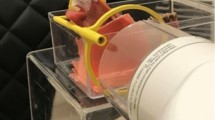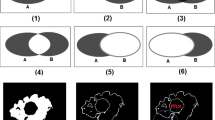Abstract
Development of medical image segmentation techniques has become one of the most important challenges in many applications that employ computers-based medical image analysis techniques. However, most of current-existing medical image segmentation techniques still have poor efficiency and complexity in calculations. A new technique for X-ray bone image segmentation has been presented in this paper. The proposed technique is designed to generate a highly-efficient quality of bone extraction from X-ray bone image at low calculation burdens. The proposed approach begins with obtaining the inverse of the original X-ray bone image then applying bounded-product operator and fuzzy controller to control the contrast of the inverse image. At the same time, an adaptive thresholding of the gradient magnitude of the original X-ray bone image is achieved to detect the edges of the bone regions. Accordingly, the bone edges are integrated with the contrasted image to give the bone segmented image. To ensure the efficient quality of the proposed algorithm, more than sixty-one of X-ray bone images were tested using much vision and statistical investigations. Then, evaluations employed several measures such as Dice similarity coefficient index, Confusion Matrix, Accuracy, Precision, Sensitivity, Specificity, and processing speed. Furthermore, results obtained using the proposed were compared to those of conventional image segmentation techniques (such as Watershed segmentation, Otsu-thresholding, K-means, and fuzzy C-means). Comparison results demonstrated the superiority of the proposed technique over other conventional techniques in both of quality and processing speed. All obtained results were obtained using MATLAB R20014a over Windows XP with processing speed 2 GHz. The high efficiency and processing speed of the proposed technique makes it such a promising solution to be implemented in many real applications.





















Similar content being viewed by others
References
Ali, I., & Melike, U. (2016). Review of MRI-based brain tumor image segmentation using deep learning methods. In 12th International conference on application of fuzzy systems and soft computing, ICAFS 2016, 29–30 August 2016, Vienna, Austria, procedia computer science (vol. 102, pp. 317–324).
Bauer, S., Wies, R., Nolte, L., & Reyes, M. (2013). A survey of MRI-based medical image analysis for brain tumor studies. Physics in Medicine and Biology,58, 97–129.
Cristina, S., & Stefan, H. (2014). An interactive X-ray image segmentation technique for bone extraction. In International conference (pp. 1164–1171). IWBBIO, Granada, Spain, 7–9 April.
Deboeverie, F., Veelaert, P., & Philips, W. (2013). Image segmentation with adaptive region growing based on a polynomial surface model. Journal of Electronic Imaging,22(4), 1–14.
Dilpreet, K., & Yadwinder, K. (2014). Various image segmentation techniques: A review. International Journal of Computer Science and Mobile Computing, IJCSMC,3(5), 809–814.
Dipanjan, D. D., & Shreya, P. (2016). Image segmentation of X-ray bone using discrete step algorithm. International Journal of Scientific and Engineering Research,4(7), 208–213.
Dunn, J. C. (1973). A fuzzy relative of the ISODATA process and its use in detecting compact well-separated clusters. Journal of Cybernetics,3, 32–57.
Gaur Sanjay, B. C., Vajpai, J., & Mehta, S. (2014). Adaptive local thresholding for edge detection. Special Issue of International Journal of Computer Applications on Electronics, Information and Communication Engineering—ICEICE No. 5 (pp. 1–5).
Hara Suthan, C. H., & Satya Narayana, R. V. S. (2014). Image segmentation based on mean shift algorithm and normalized cuts. International Journal of Advanced Research in Electrical, Electronics and Instrumentation Engineering,3(10), 12700–12704.
Horst, B. J., & Geißler, H. P. (1999). Hand book of computer vision and applications. Signal Processing and Pattern Recognition,2, 1–967.
Hussain Hassan, N. M., & Nashat, A. A. (2018). New effective techniques for automatic detection and classification of external olive fruits defects based on image processing techniques. Multidimensional Systems and Signal Processing,30, 571.
Jacob, E. N., & Wyawahare, M. V. (2013). Tibia bone segmentation in X-ray images a comparative analysis. International Journal of Computer Applications,9(76), 0975–8887.
Jitendrasinh, G. R. (2015). A review on fuzzy C-mean clustering algorithm. International Journal of Modern Trends in Engineering and Research (IJMTER),02(02), 751–754.
Joseph, D., & Peterson, D. R. (2006). The biomedical engineering handbook (Vol. Third, pp. 1–1404). Boca Raton: CRC Press.
Kazeminia, S., Karimi, N., Mirmahboub, B., Soroushmehr, S. M. R., Samavi, S., & Najarian, K. (2015). Bone extraction in X-ray images analysis of line fluctuations. In International conference on image processing, ICIP (pp. 1–6). Department of Computational Medicine and Bioinformatics, University of Michigan, USA.
Mahmoud, T. A., & Marshall (EURASIP Member), S. (2008). Edge-detected guided morphological filter for image sharpening. Journal on Image and Video Processing,970353, 1–9.
Pan, S. J., & Yang, Q. (2009). A survey on transfer learning. In IEEE transaction on knowledge and data engineering (pp. 1–15).
Panwar, P., & Gopal, G. (2016). Image Segmentation using K-means clustering and Thresholding. International Research Journal of Engineering and Technology (IRJET),03(05), 1787–1793.
Prasad, S. D., & Abi-Nahed, J. (2013). Patient oriented graph-based image segmentation. Biomedical Signal Processing and Control,8, 325–332.
Ramadevi, Y., Sridevi, T., Poornima, B., & Kalyani, B. (2010). Segmentation and object recognition using edge detection techniques. International Journal of Computer Science and Information Technology (IJCSIT),2(6), 153–161.
Ravi, S., & Khan, A. M. (2013). Morphological operations for image processing: Understanding and its applications. Conference paper, pp. 17–19. Department of ECE, University of Vignan, India.
Salman, N. (2006). Image segmentation based on watershed and edge detection techniques. The International Arab Journal of Information Technology,3(2), 104–110.
Savant, S. (2014). A review on edge detection techniques for image segmentation. International Journal of Computer Science and Information Technologies (IJCSIT),5(4), 5898–5900.
Smola, A., & Vishwanathan, S. V. N. (2008). Hand book of introduction to machine learning (pp. 1–234). Cambridge: Cambridge University Press.
Su, L., Fu, X., & Zhang, X. (2018). Delineation of carpal bones from hand X-ray images through prior model, and integration of region-based and boundary-based segmentations. Digital Object Identifier IEEE, Translations,6, 1–16.
Umadevi, N., & Geethalakshmi, S. N. (2012). Bone structure and diaphysis extraction algorithm for X-ray images. International Journal of Advanced Research in Computer Science and Software Engineering,2(2), 1–4.
Vala, H. J., & Baxi, A. (2013). A review on Otsu image segmentation algorithm. International Journal of Advanced Research in Computer Engineering and Technology (IJARCET),2(2), 387–389.
Władysław, G., & Dariusz, N. (2009). The practical course in clinical medicine. Department of essential training in clinical medicine diagnostics. Medical University of Lopz, 1-179.
Zhang, J., & Hu, J. (2008). Image segmentation based on 2D Otsu method with histogram analysis. In International conference on computer science and software engineering, Japan (pp. 105–108).
Zhanga, J. N., David, Z., & Wub, C. (2010). Interactive image segmentation by maximal similarity based region merging. Pattern Recognition, Elsevier,43, 445–456.
Zhao, F., & Xie, X. (2013). An overview of interactive medical image segmentation. Annals of the BMVA,7, 1–22.
Acknowledgements
Funding was provided by Fayoum University (Grant No. 12345).
Author information
Authors and Affiliations
Corresponding author
Additional information
Publisher's Note
Springer Nature remains neutral with regard to jurisdictional claims in published maps and institutional affiliations.
Rights and permissions
About this article
Cite this article
Hussain Hassan, N.M. Highly-efficient technique for automatic segmentation of X-ray bone images based on fuzzy logic and an edge detection technique. Multidim Syst Sign Process 31, 591–617 (2020). https://doi.org/10.1007/s11045-019-00677-0
Received:
Revised:
Accepted:
Published:
Issue Date:
DOI: https://doi.org/10.1007/s11045-019-00677-0




